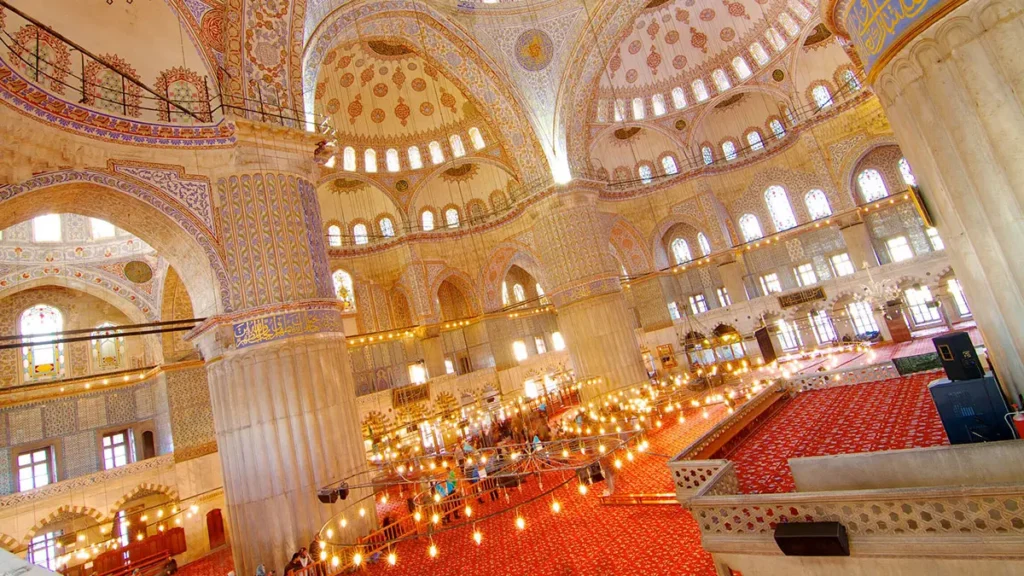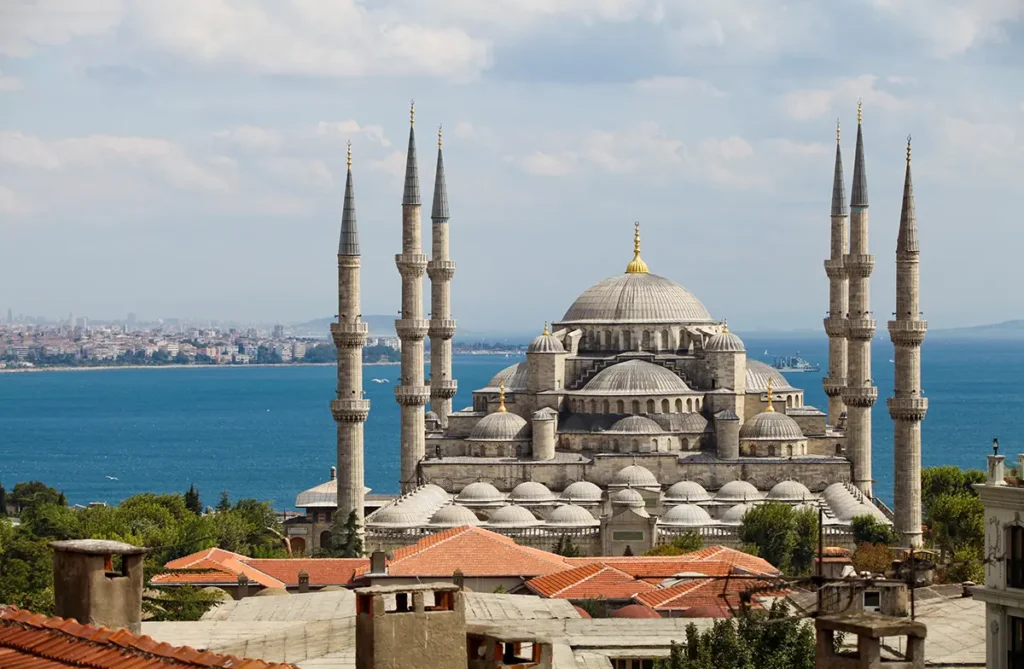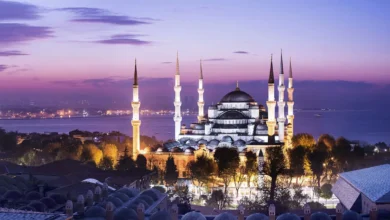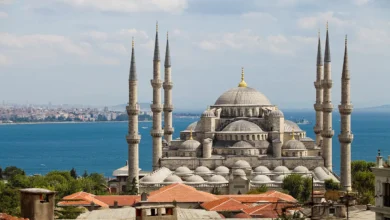
Introduction to the Blue Mosque
Located in the heart of Istanbul, Turkey, the Blue Mosque, officially known as the Sultan Ahmed Mosque, is a masterpiece of Ottoman architecture and an enduring symbol of the city’s rich cultural heritage. Constructed in the early 17th century during the reign of Sultan Ahmed I, this iconic structure combines religious significance with extraordinary artistic achievement. Its distinctive blue-tiled interior, majestic domes, and six towering minarets captivate millions of visitors annually, making it a must-see for travelers and a cherished site for worshippers alike.

Historical Background
The construction of the Blue Mosque commenced in 1609 under the patronage of Sultan Ahmed I, who sought to emphasize Ottoman power and piety. Completed in 1616, the mosque was strategically positioned near the Hagia Sophia, symbolizing the empire’s ambition to surpass the grandeur of earlier Byzantine achievements. Sultan Ahmed, despite his young age, commissioned the project to leave a lasting legacy of devotion and authority.
Designed by Sedefkar Mehmed Agha, a pupil of the legendary Ottoman architect Mimar Sinan, the Blue Mosque blends classical Ottoman style with Byzantine influences. Its cascading domes, arranged symmetrically around a commanding central dome, create a breathtaking silhouette. The six minarets—a bold and rare feature at the time—further asserted the mosque’s prominence, marking it as one of the most architecturally daring structures of its era ue’s opulent interior, adorned with over 20,000 hand-painted blue İznik tiles, enhances its artistic and spiritual allure. The intricately decorated space not only served as a center for worship but also as a visual statement of the empire’s sophistication and prosperity.
A Legacy of Ottoman Grandeur
The Blue Mosque epitomizes the artistic and architectural mastery of the Ottoman Empire. Its blend of visual splendor and spiritual depth has cemented its status as one of Istanbul’s most treasured landmarks. With its soaring domes, intricate tilework, and six towering minarets, the mosque reflects the empire’s ambition to create structures of unmatched elegance and cultural significance.

Architectural Features
The Blue Mosque is an architectural marvel, both for its exterior and interior elements. The exterior is dominated by cascading domes and six slender minarets, a rare feature that signifies its grandeur. The mosque’s name is inspired by the intricate blue İznik tiles adorning its walls, creating a striking visual appeal. Inside, visitors are greeted by elaborate calligraphy, awe-inspiring arches, and a central dome that creates a sense of vastness and unity.
A Vision in Blue
The dazzling İznik tiles are the hallmark of the Blue Mosque. These hand-painted masterpieces feature vibrant floral and geometric patterns, predominantly in shades of blue and turquoise. They lend a luminous quality to the mosque’s interior, reflecting light from the strategically placed stained-glass windows, creating an almost celestial atmosphere.
A Harmony of Light and Space
Stepping inside the mosque immerses visitors in an ambiance of light and serenity. The 260 windows allow natural light to illuminate the intricacies of the mosque’s interiors. Unlike many sacred spaces with figurative art, the Blue Mosque focuses on abstract beauty through Quranic calligraphy and symmetrical patterns, emphasizing spiritual reflection over imagery.
A Blend of Tradition and Modernity
Even with its historic prominence, the Blue Mosque remains an active place of worship. Visitors can explore it outside of prayer hours, provided they adhere to respectful dress codes. Beyond its religious function, the mosque hosts cultural events and remains a central part of Istanbul’s vibrant heritage, bridging centuries of tradition with its enduring relevance.

Significance and Influence
The Blue Mosque, or Sultan Ahmed Mosque, holds profound cultural and religious significance not only in Turkey but also within the broader Muslim world. As an active place of worship, it serves as a spiritual and social gathering spot, hosting regular prayers, festivals, and community events. Its towering presence and architectural beauty symbolize the Ottoman Empire’s grand legacy, while also reflecting Islamic artistic traditions.
Beyond its religious role, the Blue Mosque has become a major cultural and tourist attraction. Millions of visitors from across the globe are drawn to admire its stunning design, which seamlessly blends Islamic and Byzantine elements, and to learn about Islamic art and architecture. The mosque’s intricate İznik tiles, expansive domes, and monumental minarets have inspired the design of numerous mosques worldwide, cementing its influence in the field of Islamic architecture.
Its architectural achievements, particularly the innovative use of space and light, set a precedent for subsequent mosque designs, influencing both Ottoman architecture and later Islamic buildings globally. The mosque’s lasting legacy is a testament to its ability to merge artistry with function, creating a space that serves both spiritual and cultural purposes.

Tourist Destination

Conclusion
In conclusion, the Blue Mosque is a remarkable testament to the rich cultural heritage and architectural prowess of Istanbul. Its historical significance, stunning design, and cultural impact make it a must-visit destination for travelers and a source of pride for the Turkish people.
Today, the Blue Mosque endures as a popular tourist destination and a cherished landmark for Istanbulites. It serves as a powerful reminder of the artistry and architectural prowess of the Ottoman era. The Blue Mosque’s captivating beauty and rich history continue to inspire awe and wonder in all who visit.
FAQs
- Can you take pictures inside the Blue Mosque? Yes, visitors can take pictures inside, but it’s important not to photograph people who are praying. Flash photography is also prohibited to preserve the space and respect the atmosphere.
- Do you need to wear a hijab? Women are required to cover their heads when entering the mosque. If you forget a scarf, one can be provided at the entrance. Modest clothing is expected for both men and women, with no shorts allowed.
- Is there an entrance fee? There is no entrance fee to visit the Blue Mosque. However, donations to help with its upkeep are appreciated.
- What is the best time to visit? To avoid crowds, it’s best to visit early in the morning, after the dawn prayers, or later in the afternoon. The mosque can get busy during prayer times, and on Fridays, it opens only after the midday prayer.
- Can tourists visit the Blue Mosque during prayer times? The mosque remains open to visitors outside prayer times. However, during the five daily prayers, it is closed to tourists.
- How do you get there? The Blue Mosque is located in Sultanahmet and can be reached by taxi, bus, or tram. It’s a short walk from Sultanahmet Tram Station.
- Is the Blue Mosque still a functioning mosque? Yes, the Blue Mosque is still a place of worship, and visitors are welcome during non-prayer times to admire the architecture and atmosphere.





